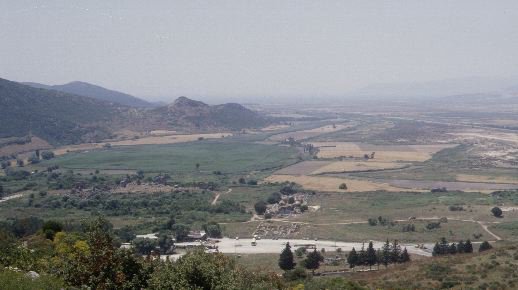Omphale, the Barbarian Queen
The Lydian queen Omphale actually owned Hercules, as a slave. She bought the hero from the god Hermes, who sold him following an oracle which declared that Hercules must be sold into slavery for three years.
Hercules had sought the oracle to find out what he had to do in order to purify himself, after he murdered his friend Iphitus and stole the Delphic tripod.

Berlin F 2180, Attic red figure calyx krater, ca. 510-500 B.C.
An athlete's slave boy helps him prepare for competition.
Photograph by Maria Daniels, courtesy of the Staatliche Museen zu Berlin, Preußischer Kulturbesitz: Antikensammlung
The Athenian playwright Sophocles imagined Hercules feeling deep dishonor at being forced into slavery, "so stung was he by the shame of it." Slaves in Greek society often came from non-Greek regions, so the enslavement of the great Hercules by a barbarian queen from Lydia would have seemed an especially outrageous reversal to the Greeks. During this time of servitude, the hero continued his amazing feats, ridding yet another part of the world of monsters.
|
...Lydia indeed obtained great peace and security; but in the regions of Hellas the old villainies burst forth and broke out anew, there being none to rebuke and none to restrain them.
Plutarch, Theseus 6.5 |
Lydia was an ancient kingdom in southwestern Asia Minor, in what is modern-day Turkey. The Lydians were not a Greek-speaking people, so they were considered barbarians by the Greeks. Lydia's capital, the city of Sardis, was described as "rich in gold." Sardis was built along the Pactolus River, which flowed from Mount Tmolus carrying deposits of gold. The Lydians built a gold refining operation on the banks of the Pactolus, and they became quite wealthy.

View from N peak of Mt. Pion, at Ephesos, toward W and the sea. Ephesos was in the region of Ionia, bordering Lydia.
Photograph by Don Keller
One Lydian king, Croesus, made a lavish display of his riches at the Greek sanctuary of Delphi, hoping to win Apollo's favor (and show his neighbors how rich he was). Croesus sacrificed three thousand beasts, and burned enormous couches covered with gold and silver, golden goblets, and purple cloaks and tunics. The king's sacrifices were so valuable that his name became synonomous with wealth; even today, we use the phrase, "rich as Croesus."

Dewing 2423, electrum trite minted at Sardis, c. 737-560 B.C.
Obverse: lion's head.
Photograph by Maria Daniels, courtesy of the Dewing Greek Numismatic Foundation
The ancient historian Herodotus claims that the Lydians were the first people to use coinage, which they made from the gold they refined. Many Lydian coins were made of an alloy of gold and silver called electrum.
(md)
To read more about these topics, see Further Resources.
This exhibit is a subset of materials from the Perseus Project digital library and is copyrighted. Please send us your comments.